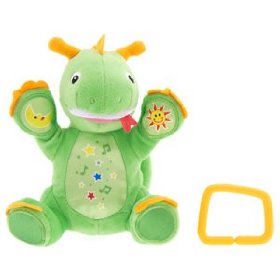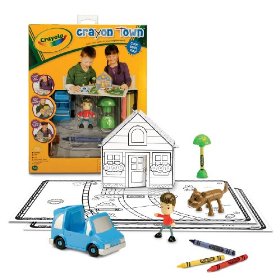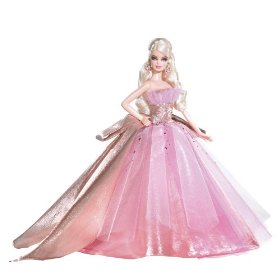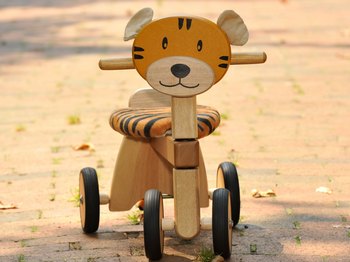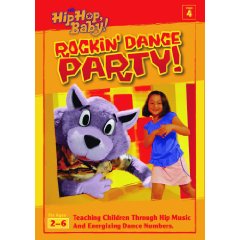Here are my qualifications – I’ve got an almost-two year old, I worked for two years in a residential facility for kids with Mental Retardation and Behavioral Disorders (the toughest behavior cases out there) and lived to tell about it, and I went to school to be a Special Ed teacher (and took Applied Behavioral Analysis and other courses to learn how to deal with kids).
The most common misconception I read/see/hear is that a time out is for punishment. It is not. The time out serves two purposes.
- It removes the misbehaving child from whatever stimulus or situation is causing the misbehavior (so, if little Sally is hitting little Johnny, it removes Sally from Johnny’s presence, which interrupts the hitting behavior).
- It reestablishes parental authority (in other words, it reminds the child who is in charge).
I think a lot of people think that the time out is a punishment because it has been touted as an alternative to spanking (which is a punishment). However, if you use Time Out incorrectly, as a punishment, you’re defeating the actual purpose of the time out and making your job, as parent, much harder.
The recommended guideline for the duration of a time out is one minute for every year of age. So, a two year old gets a two minute time out. (I recently saw a time out bear, which I refuse to link to because it’s a bad idea, but it had a timer that went up to 60 minutes, and I kept wondering if there were parents out there giving their kids’ grandparents time outs, too… Then I thought it might not be a bad idea. You hear that Dad? I’m coming for you with the time out bear if you don’t behave yourself… Nevermind that you’re 56 years old. The timer will work for you for 4 more years!!)
Anyway, we started with time outs for MG when she was one. This also happened to be when she started needing them. We reserve time outs for egregious behavior – in the beginning it was only for things that could hurt her or someone else (i.e., tormenting the dog, jumping on the couch, biting, etc.). Now we’ve started to use it for property destruction infractions, too, but I’ll get to that.
This is how it should work
Child is misbehaving. Parent says, “Child, if you do not stop doing X, you’re going to get a time out.” Child continues to misbehave. Parent says, “I’m sorry you’re choosing to do X, you need to come take a time out.”
You then remove the child to the time out area. We started with the crib, but now we do them at the bottom of the stairs (on the lowest step or on the rug in front of the stairs – and you all just thought I was weird for having a bath mat at the bottom of the stairs!!). I don’t believe in having a single place (like a “Naughty Chair”) to take time outs. First, because if you say, “You will sit THERE” you get into a power struggle. If you say, “You can take your time out here or there,” you’re still allowing the child choices, and you’re less likely to get into a senseless power struggle. Second, because if the child is used to a single chair, what do you do when you go out? Take it with you? Stairs and rugs are common enough, though, that you can find them virtually anywhere, and having multiple locations makes it easier for the child to generalize when you’re at Grandma’s, say, and you have to do time out on a chair instead of a step.
Assuming that the child goes willingly (I’ll get to unwilling children in a second), you start a timer and say, “Good job. You’ve got two more minutes.” If the child wants to scream and cry and freak out, that’s ok. In addition to removing them from the situation that causes the misbehavior, allowing them to scream and holler allows them to release some of the frustration/tension that the situation has caused. This is healthy. The place where I worked required the children to be “calm and compliant” before the time out countdown started, but I think that’s crazy. I don’t care if MG cries the whole two minutes, as long as she is on the step or the rug.
Anyway, you sit there for the two minutes with them, giving comfort with your presence but not talking to them (except to maybe remind them to stay in the time out area, or say, “It’s ok,” or “You’re doing fine,” or “Calm down,” occasionally). This is not the time to have a discussion about what happened. Just give them that two minutes to get control of themselves. Be encouraging and supportive, but not too much. A word or two here or there is all you need. A lot of parents talk too much, in general. That’s another post…
When the timer beeps, get down on the child’s level and give her a hug. She needs reassurance that you still love her, no matter what she did. Then you explain, in terms that she can understand, why she got the time out. “Child, you did X, so I had to give you a time out. Next time when you feel Y, instead of doing X, you could try doing Z instead.” (Next time you feel frustrated, instead of hitting your sister, you could try walking away, instead.) You are Teaching here, not punishing. You want them to understand what you expect. So tell them, and use small, understandable words. “You got a time out because you ran out into the street without looking both ways. Next time you want to cross the street, you need to wait for me to hold your hand, and look both ways.” You don’t need to use scare tactics “A big truck could squash you!!!” You don’t want to create fear. You simply want to instruct the child on what’s expected. If the child is old enough, have them repeat back the situation and the behavior to you. Say, “Now, next time you get frustrated, what are you going to do?” and encourage the child to say, “Walk away.” This may take time to get right, and is over the head of little kids, but you can ask the question and then answer it for him. Eventually he’ll understand what you want to hear. Repeating it to you will help him internalize the correct behavior.
You always want to end a time out positively. “I love you,” or “Good job,” and then, the most important step, “Let’s go do something else!” Redirect the child to an appropriate activity, NOT the activity that caused the problem to begin with. If the kid threw a block at his sister’s head, you don’t want to send him back to play with the blocks. Give him something soft! :)
Just as it takes a dozen exposures to a new food before a child will like it, it often takes a dozen time outs for the same offense before a child “gets it.” This is why parents everywhere have said, “I’ve told you a thousand times….” (and then groaned because they sound just like their own parents!)
It will also take more than a dozen tries before your child understands what a time out is. That’s ok. You’re teaching. Rome wasn’t built in a day.
What do you do if the child won’t take his time out? You suspend all attention, fun, and most interaction until he does. If he talks to you, you say, “I will talk to you after you take your time out.” If he says, “I want some water,” you say, “You can have a drink of water after you take your time out.” If he says, “I need a clean diaper,” you say, “You can have a new diaper after you take your time out.” I’m not kidding. The universe stops until the time out is over. If the child goes off and plays by himself, fine. The greatest currency you have with your kids is your attention. So you withhold it until he’s taken his time out. We’re only talking about two minutes, here. It isn’t child abuse to sit in a wet diaper for two minutes. It isn’t child abuse to withhold dinner for two minutes. If the child CHOOSES to make it two hours instead of two minutes, well, fine. That’s his choice. Children aren’t harmed by one missed (or delayed) meal or drink. Oh, and try to keep it positive. You CAN have X after you take your time out, instead of, you can’t have X until you’ve taken your time out. I’m not sure why, but it makes a difference.
Try to be as neutral as possible. You’re going to be frustrated. You’ll want to say, “It’s just two freaking minutes, will you take your time out already so we can GO???” Don’t show it. If you say that, he’ll know that you want to go, and that by not taking his time out, he can needle you. He can “win.” Don’t show your hand. Don’t let him know what your currency is. Be as calm and neutral as possible (always, not just with time outs). I know this is impossible. Just last night, MG was driving me crazy, and I lost my cool. Luckily her Dad was home, so he could be the good cop while I chilled out. (It’s a natural reaction when your toddler sticks her hand onto the cutting board where you’re cutting carrots to freak out a little. She’s really lucky I didn’t cut off her fingers… Argh.)
I didn’t think that Time Outs were working with MG, because she screamed like a crazy person every time I gave her one at home. Then we were at Grandpa Ben’s farm, and she colored on the TV with a crayon (property destruction). I gave her a time out and braced myself for one of those scenes that you don’t want your kids to have in front of your in-laws, no matter how cool and understanding they are… But damned if she didn’t march right over and sit down on the step and take her time out like a little angel. I was absolutely stunned. It was one of my proudest parenting moments.
I would be happy to elaborate or answer any questions you may have about time outs, or discipline in general. I hope that this has helped you understand how to use the time out correctly and effectively!
Works for me!
Amy is the mother of Mary Grace, 4, and Claire, 2, as well as Maxine the Dog, 9, and Kona the Cat, 13. When she isn’t taking the mommyblogosphere by storm, she’s doing rocket science with her husband, BJ, in the business that they own.
 Are you ready for an incredible deal? Here we go…
Are you ready for an incredible deal? Here we go… 
